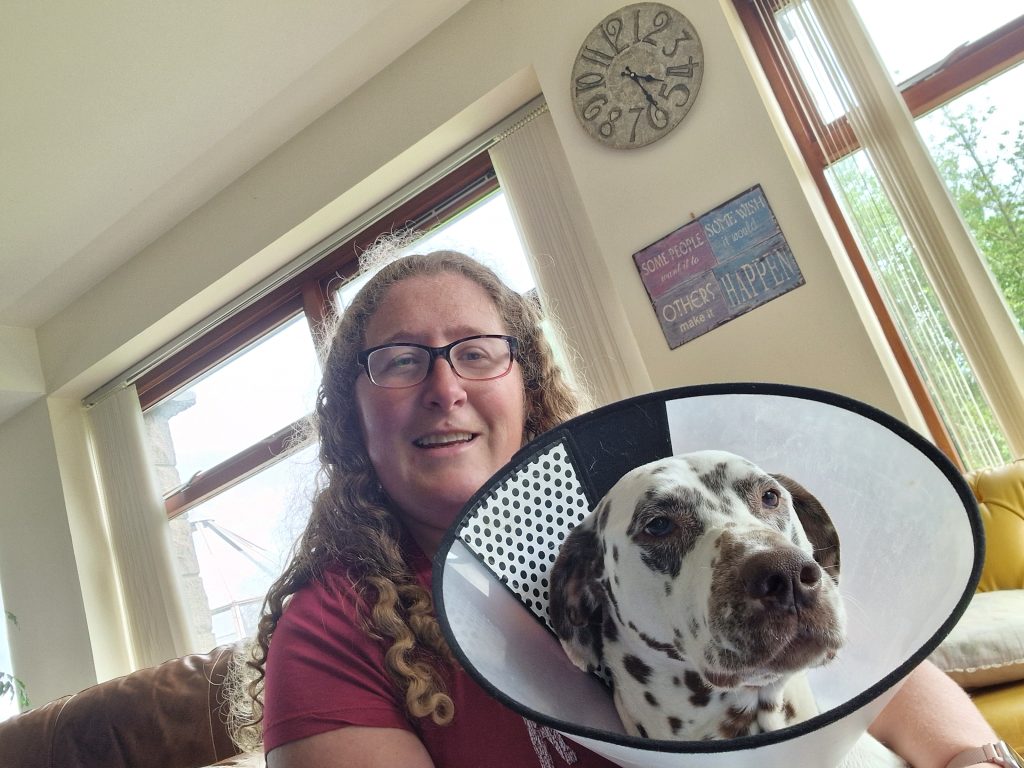Sofa snuggles are one of the great joys of having a dog, but what about those times when your furry friend can’t be on the furniture? In my home, it’s a mixed policy: my Pomchi, Emba, and my daughter’s Chihuahua, Dexter, are allowed on the sofa, but Mungo the Spaniel and Siri the Dalmatian are not. Here’s why a balanced approach to sofa time is useful for both you and your dog.
Should Your Dog Be Able to Stay Off the Sofa?
It’s entirely fine if you love having your dog on the sofa; it’s a personal choice that brings comfort and closeness to many people. However, there are practical reasons why teaching your dog to stay off the sofa can be helpful, particularly when:
Health and Recovery
If your dog is recovering from surgery or has joint issues, it’s best to keep them off the sofa to avoid further strain. Jumping on and off high furniture can exacerbate injuries and delay healing, particularly for breeds prone to joint problems like hip dysplasia.Guests and Visitors
Not all visitors feel comfortable sharing the sofa with dogs. Whether due to allergies, fear of dogs, or simply preference, having a well-trained dog who can stay off the sofa when needed helps avoid awkward situations and keeps everyone comfortable.Keeping Things Clean
Sometimes, keeping the sofa dog-free makes life easier. After a muddy or rainy walk, you might not want to clean the sofa yet again. Or, if you’ve just invested in a new sofa, you may want to keep it pristine.
Training Your Dog to Stay Off the Sofa (Sometimes)
Letting your dog on the sofa doesn’t mean you can’t teach them to stay off it when needed. A simple and effective way to create a balance is by using a mat as a designated ‘dog zone.’ When the mat is on the floor, it’s “no sofa” time; when the mat isn’t present, it’s an invitation to join you for snuggles. This method offers a clear and consistent cue for your dog while providing them with a cosy alternative.
Teaching Your Dog to Settle on a Mat
Here’s a step-by-step guide for training your dog to relax on their mat, using shaping (no cues needed):
Choose a Mat
Pick a comfortable mat different from your dog’s regular bed. Ensure it’s portable and large enough for them to lie down comfortably.Introduce the Mat Gradually
Place the mat on the floor and let your dog investigate. Reward them with a treat or praise when they show interest, making the mat a positive experience.Reward for Sitting or Lying Down on the Mat
As your dog becomes more comfortable, they may sit or lie down on the mat. Reward this behaviour, reinforcing that lying on the mat brings rewards.Build Duration Gradually
Start with frequent rewards for staying calm on the mat, gradually extending the time between rewards to help them settle for longer periods.Take the Mat Away When Not in Use
For clarity and consistency, only put the mat down when you want your dog to settle on it. When it’s picked up, your dog knows “mat time” is over.Practice in Different Locations
Once your dog is confident on the mat at home, practise in various locations. This can help your dog associate the mat with calmness, wherever it is placed.
Why a Mat is Practical
The mat isn’t just for home—it’s incredibly useful when visiting friends or family where dogs aren’t allowed on the sofa. Bringing the mat along gives your dog a familiar space to settle in, helping them feel comfortable while respecting house rules.
Finding the Balance
Whether or not your dog is allowed on the sofa is entirely up to you, but having the option to keep them off when needed can be practical and beneficial. Whether for health reasons, visitors, or cleanliness, training your dog to settle on a mat allows you to maintain a balanced approach to sofa time.
For full mat training videos and more techniques to master the sofa-snuggle balance, check out Wags without Walks, my online membership programme. Designed to keep your dog happy and mentally stimulated even when physical exercise is limited, the programme offers a library of training videos, plus weekly Zoom sessions for troubleshooting and support.
So, whether you’re in training mode or just looking to create a balanced, happy life with your dog, Wags without Walks can help you get there.
Until next time, keep those tails wagging!
Laura Carter IMDT

With over 15 years of experience in dog training, Laura Carter has dedicated her career to enhancing the bond between humans and their canine companions.
Based in Scotland, Laura lives with her twin daughters, four dogs, and a variety of other animals.
A member of the Institute of Modern Dog Trainers (IMDT) and a certified Scentwork UK instructor, Laura brings a wealth of knowledge and expertise to her work.
Her expertise in dog care and rehabilitation is showcased in the book The Vet Says Rest, a valuable resource for pet owners navigating their dogs’ recovery.
Laura also brought her passion for dogs to a wider audience as a trainer on Channel 4’s Superstar Dogs alongside John Barrowman.
Her work continues to inspire and support dog owners everywhere, helping them build happier, healthier relationships with their pets.